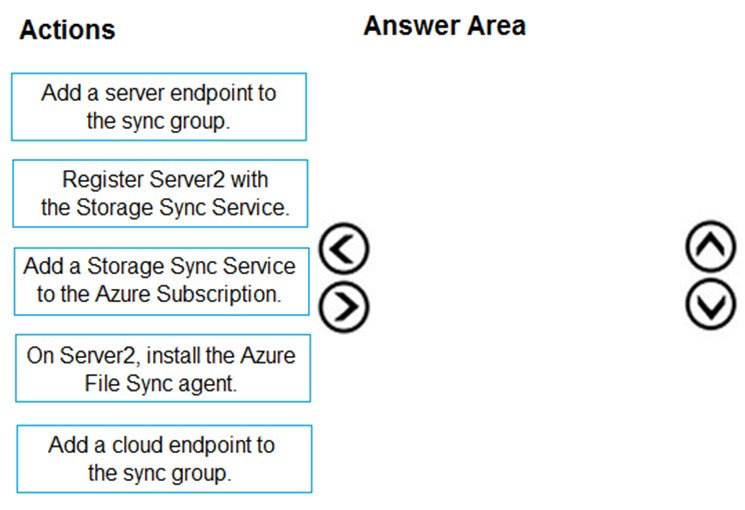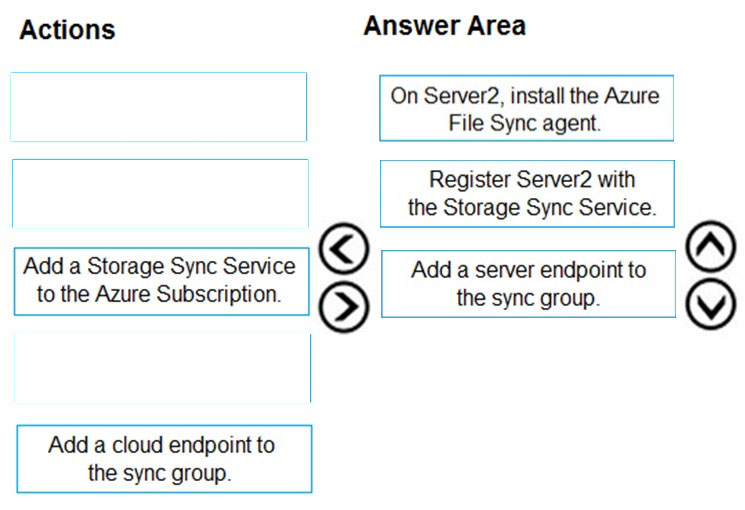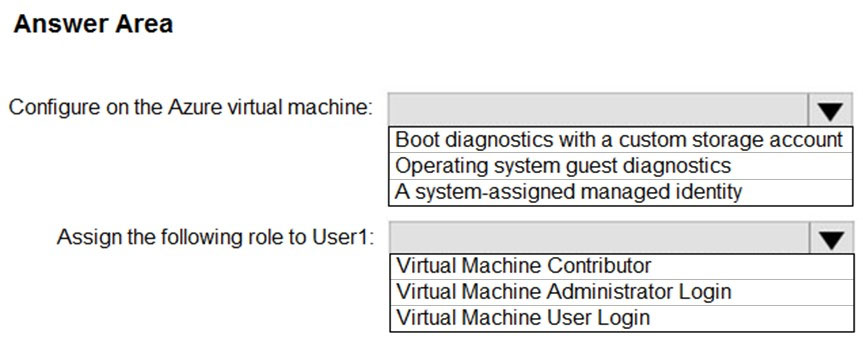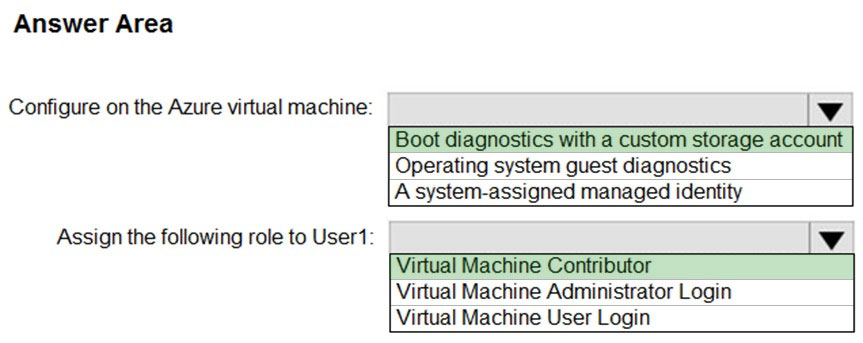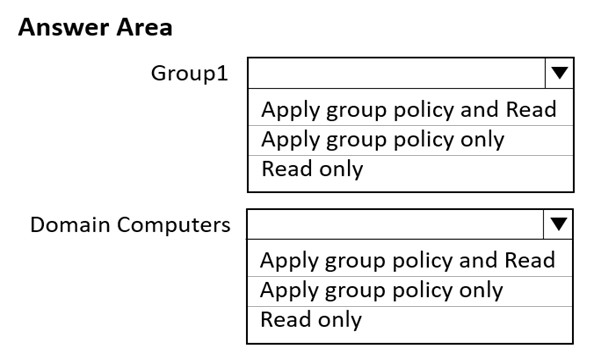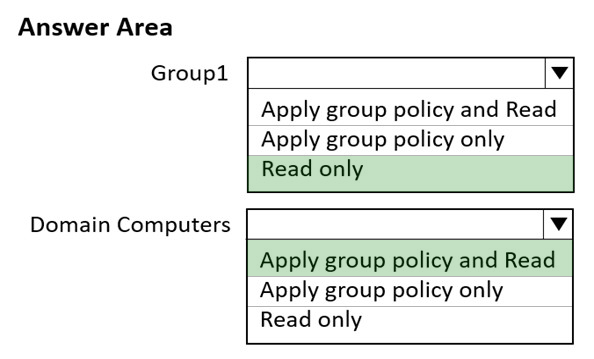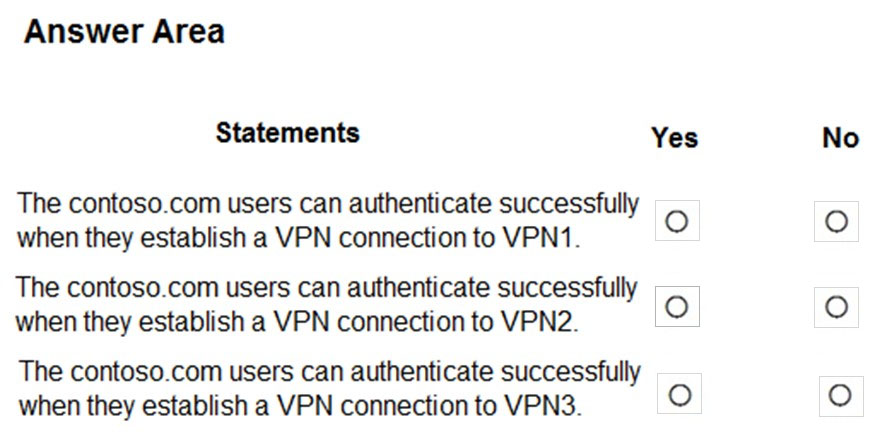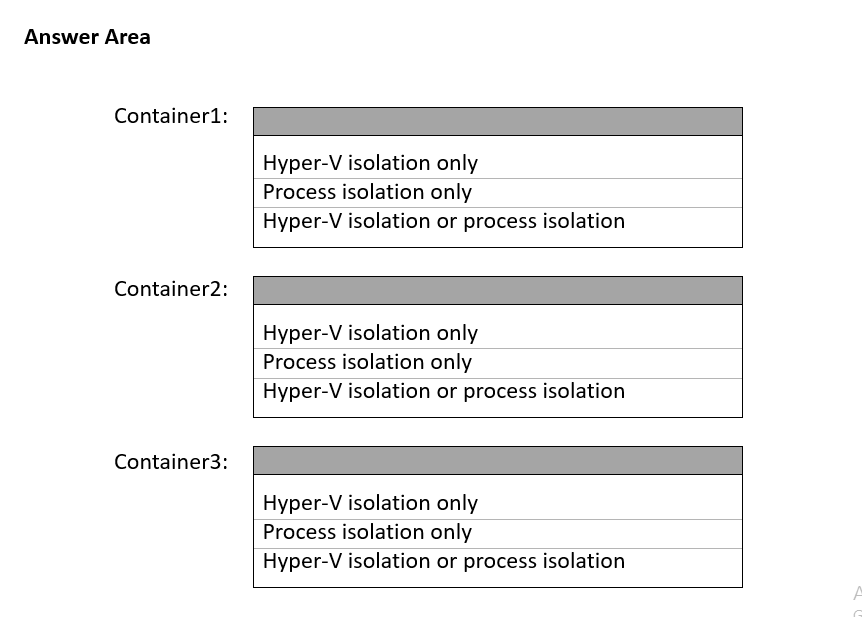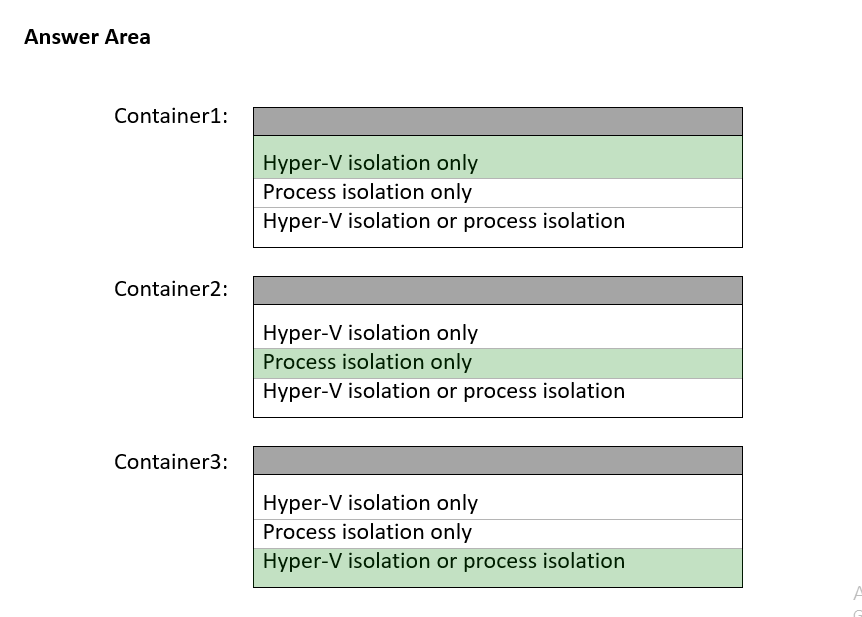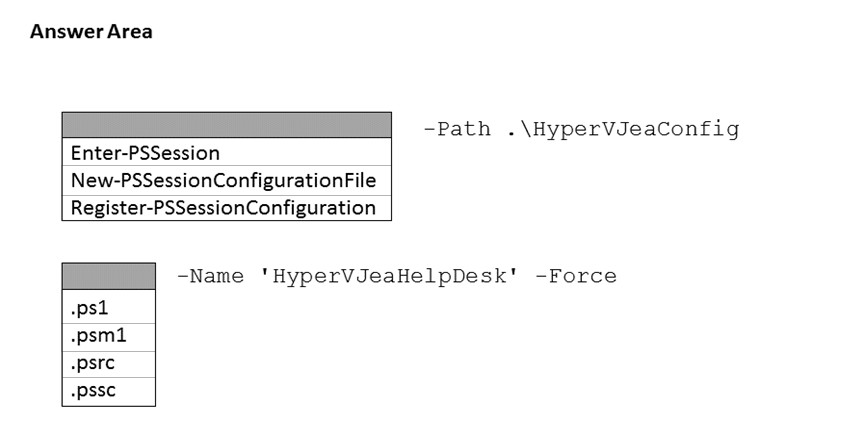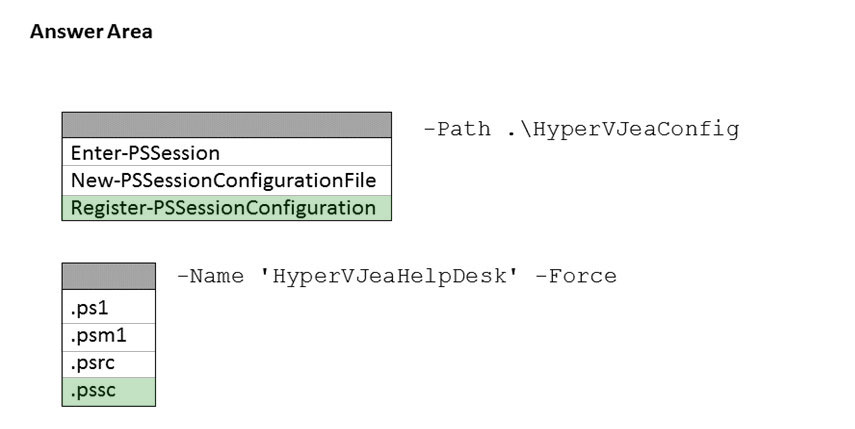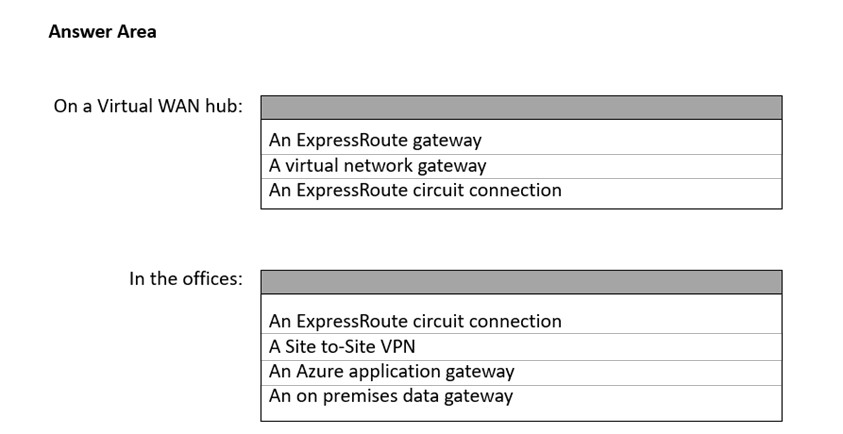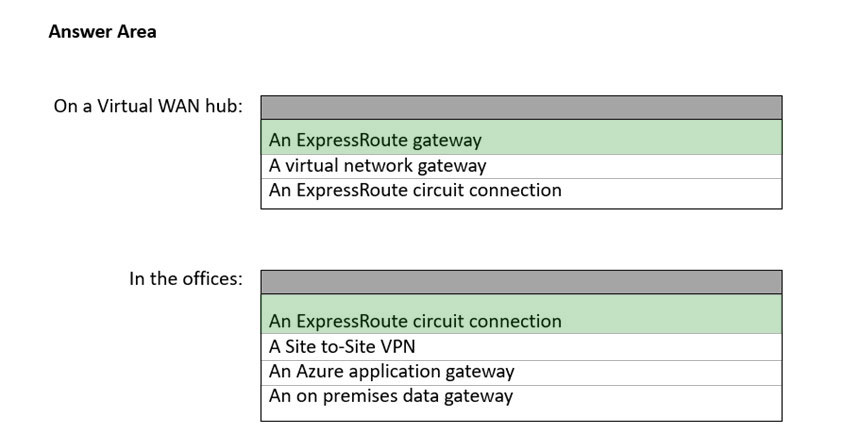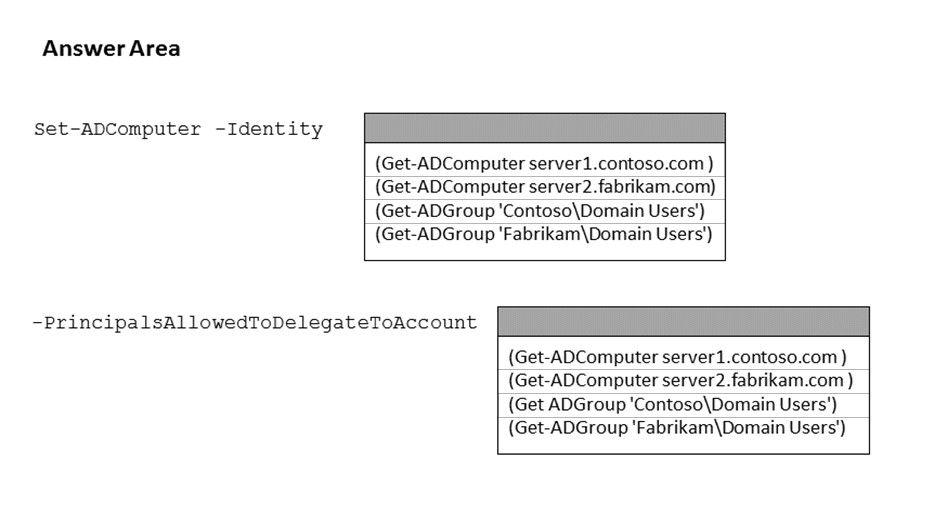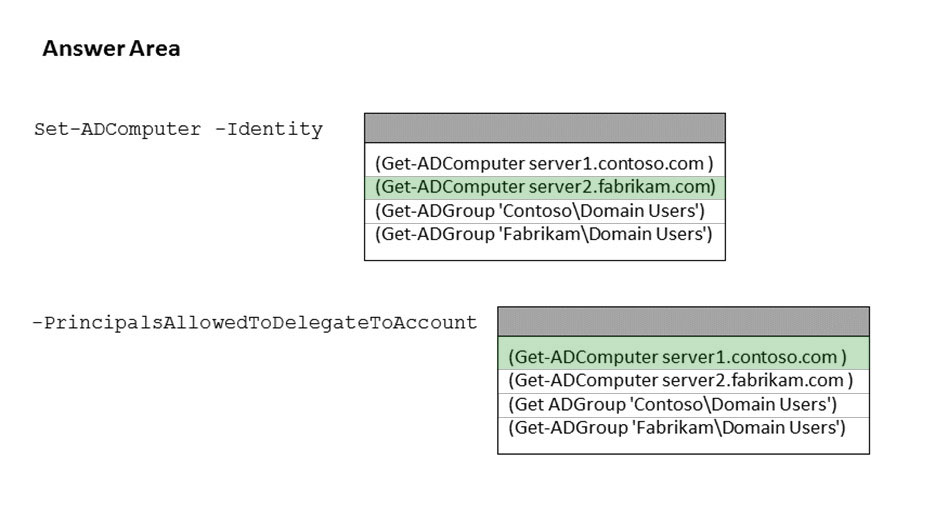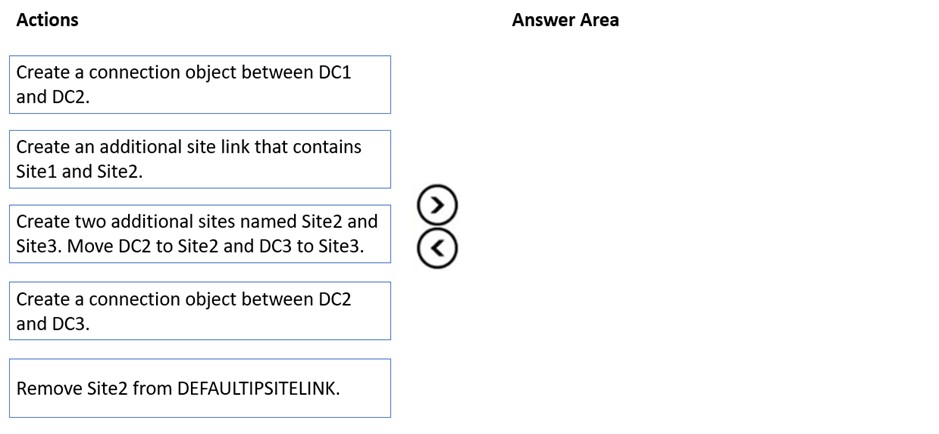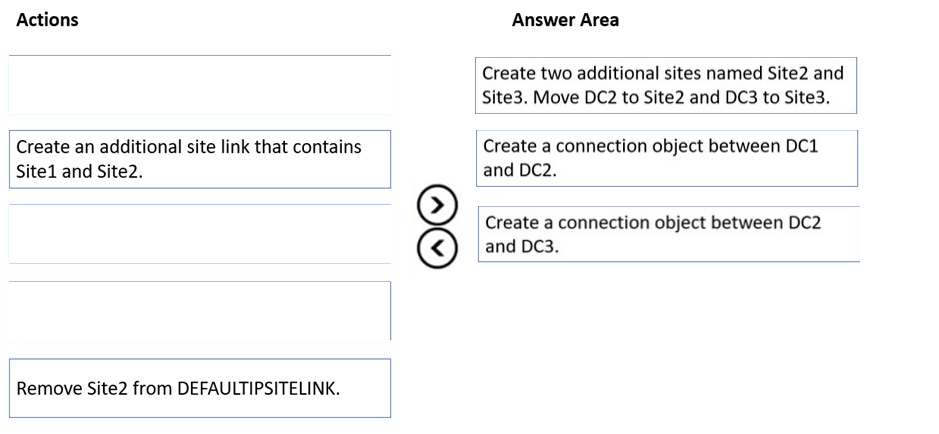AZ-800 Practice Questions Free – 50 Exam-Style Questions to Sharpen Your Skills
Are you preparing for the AZ-800 certification exam? Kickstart your success with our AZ-800 Practice Questions Free – a carefully selected set of 50 real exam-style questions to help you test your knowledge and identify areas for improvement.
Practicing with AZ-800 practice questions free gives you a powerful edge by allowing you to:
- Understand the exam structure and question formats
- Discover your strong and weak areas
- Build the confidence you need for test day success
Below, you will find 50 free AZ-800 practice questions designed to match the real exam in both difficulty and topic coverage. They’re ideal for self-assessment or final review. You can click on each Question to explore the details.
HOTSPOT - Your on-premises network contains a server named Server1 and uses an IP address space of 192.168.10.0/24. You have an Azure virtual network that contains a subnet named Subnet1. Subnet1 uses an IP address space of 192.168.10.0/24. You need to migrate Server1 to Subnet1. You must use Azure Extended Network to maintain the existing IP address of Server1. What is the minimum number of virtual machines that you should deploy? To answer, select the appropriate options in the answer area. NOTE: Each correct selection is worth one point.
HOTSPOT - You have a Windows Server container host named Server1. You start the containers on Server1 as shown in the following table.You need to validate the status of ProcessA and ProcessC. Where can you verify that ProcessA and ProcessC are in a running state? To answer, select the appropriate options in the answer area. NOTE: Each correct selection is worth one point.
DRAG DROP - You have two on-premises servers named Server1 and Server2 that run Windows Server. You have an Azure Storage account named storage1 that contains a file share named share1. Server1 syncs with share1 by using Azure File Sync. You need to configure Server2 to sync with share1. Which three actions should you perform in sequence? To answer, move the appropriate actions from the list of actions to the answer area and arrange them in the correct order. Select and Place:
HOTSPOT - Your network contains an Active Directory Domain Services (AD DS) domain. The domain contains the domain controllers shown in the following table.You need to configure DC3 to be the authoritative time server for the domain. Which operations master role should you transfer to DC3, and which console should you use? To answer, select the appropriate options in the answer area. NOTE: Each correct selection is worth one point.
Your network contains an Active Directory Domain Services (AD DS) forest. The forest contains three domains. Each domain contains 10 domain controllers. You plan to store a DNS zone in a custom Active Directory partition. You need to create the Active Directory partition for the zone. The partition must replicate to only four of the domain controllers. What should you use?
A. Windows Admin Center
B. DNS Manager
C. Active Directory Sites and Services
D. ntdsutil.exe
Your network contains an on-premises Active Directory Domain Services (AD DS) domain named contoso.com. The domain contains three servers that run Windows Server and have the Hyper-V server role installed. Each server has a Switch Embedded Teaming (SET) team. You need to verify that Remote Direct Memory Access (RDMA) and all the required Windows Server settings are configured properly on each server to support an Azure Stack HCI cluster. What should you use?
A. Server Manager
B. the Get-NetAdapter cmdlet
C. Failover Cluster Manager
D. the Validate-DCB cmdlet
You need to meet the technical requirements for VM3. On which volumes can you enable Data Deduplication?
A. C and D only
B. D only
C. C, D, E, and F
D. D and E only
E. D, E, and F only
Your network contains an Active Directory Domain Services (AD DS) domain. The domain contains 10 servers that run Windows Server. The servers have static IPv4 addresses. You plan to use DHCP to assign IPv4 addresses to the servers. You need to ensure that each server always receives the same IPv4 address. Which type of identifier should you use to create a DHCP reservation for each server?
A. fully qualified domain name (FQDN)
B. universally unique identifier (UUID)
C. NetBIOS name
D. MAC address
Your network contains an Active Directory Domain Services (AD DS) forest. The forest contains three domains. Each domain contains 10 domain controllers. You plan to store a DNS zone in a custom Active Directory partition. You need to create the Active Directory partition for the zone. The partition must replicate to only four of the domain controllers. What should you use?
A. Windows Admin Center
B. Set-DnsServer
C. New-ADObject
D. ntdsutil.exe
SIMULATION - You need to configure SRV1 as a DNS server. SRV1 must be able resolve names from the contoso.com domain by using DC1. All other names must be resolved by using the root hint servers. To complete this task, sign in the required computer or computers.
HOTSPOT - You plan to deploy an Azure virtual machine that will run Windows Server. You need to ensure that an Azure Active Directory (Azure AD) user named user1@contoso.com can connect to the virtual machine by using the Azure Serial Console. What should you do? To answer, select the appropriate options in the answer area. NOTE: Each correct selection is worth one point. Hot Area:
Your network contains an Active Directory Domain Services (AD DS) domain. The network also contains 20 domain controllers, 100 member servers, and 100 client computers. You have a Group Policy Object (GPO) named GPO1 that contains Group Policy preferences. You plan to link GPO1 to the domain. You need to ensure that the preference in GPO1 apply only to domain member servers and NOT to domain controllers or client computers. All the other Group Policy settings in GPO1 must apply to all the computers. The solution must minimize administrative effort. Which type of item level targeting should you use?
A. Domain
B. Operating System
C. Security Group
D. Environment Variable
HOTSPOT - You have a Group Policy Object (GPO) named GPO1 that contains user settings only. You plan to apply GPO1 to a global security group named Group1. You link GPO1 to the domain, and you remove all the permissions granted to the Authenticated Users group. You need to configure permissions for GPOI to meet the following requirements: ✑ GPO1 must apply only to the users in Group1. ✑ The solution must use the principle of least privilege. Which permissions should you grant to Group1 and the Domain Computers group? To answer, select the appropriate options in the answer area. NOTE: Each correct selection is worth one point. Hot Area:
Your network contains a single-domain Active Directory Domain Services (AD DS) forest named contoso.com. The forest contains the servers shown in the following exhibit table.You plan to install a line-of-business (LOB) application on Server1. The application will install a custom Windows service. A new corporate security policy states that all custom Windows services must run under the context of a group managed service account (gMSA). You deploy a root key. You need to create, configure, and install the gMSA that will be used by the new application. Which two actions should you perform? Each correct answer presents part of the solution. NOTE: Each correct selection is worth one point
A. On Server1, run the setspn command.
B. On DC1, run the New-ADServiceAccount cmdlet.
C. On Server1, run the Install-ADServiceAccount cmdlet.
D. On Server1, run the Get-ADServiceAccount cmdlet.
E. On DC1, run the Set-ADComputer cmdlet.
F. On DC1, run the Install-ADServiceAccount cmdlet.
You have servers that run Windows Server 2022 as shown in the following table.Server2 contains a .NET app named App1. You need to establish a WebSocket connection from App1 to the SQL Server instance on Server1. The solution must meet the following requirements: • Minimize the number of network ports that must be open on the on-premises network firewall. • Minimize administrative effort. What should you create first?
A. an Azure Relay namespace
B. an Azure VPN gateway
C. a WFC relay connection
D. a hybrid connection
HOTSPOT - Your network contains an Active Directory Domain Services (AD DS) domain named contoso.com. The domain contains the VPN servers shown in the following table.You have a server named NPS1 that has Network Policy Server (NPS) installed. NPS1 has the following RADIUS clients:
VPN1, VPN2, and VPN3 use NPS1 for RADIUS authentication. All the users in contoso.com are allowed to establish VPN connections. For each of the following statements, select Yes if the statement is true. Otherwise, select No. NOTE: Each correct selection is worth one point. Hot Area:
HOTSPOT - You have a Windows Server container host named Server1 that has a single disk. On Server1, you plan to start the containers shown in the following table.Which isolation mode can you use for each container? To answer, select the appropriate options in the answer area. NOTE: Each correct selection is worth one point. Hot Area:
HOTSPOT - You have an Azure subscription that contains the virtual machines shown in the following table.You plan to implement Azure Automanage for Windows Server. You need to identify the operating system prerequisites. Which virtual machines support Hotpatch, and which virtual machines support SMB over QUIC? To answer, select the appropriate options in the answer area. NOTE: Each correct selection is worth one point.
HOTSPOT - You have a server named Server1 that runs Windows Server and has the Hyper-V server role installed. You need to limit which Hyper-V module cmdlets helpdesk users can use when administering Server1 remotely. You configure Just Enough Administration (JEA) and successfully build the role capabilities and session configuration files. How should you complete the PowerShell command? To answer, select the appropriate options in the answer area. NOTE: Each correct selection is worth one point. Hot Area:
You have an on-premises Active Directory Domain Services (AD DS) domain that syncs with an Azure Active Directory (Azure AD) tenant. Group writeback is enabled in Azure AD Connect. The AD DS domain contains a server named Server1. Server1 contains a shared folder named share1. You have an Azure Storage account named storage2 that uses Azure AD-based access control. The storage2 account contains a share named share2. You need to create a security group that meets the following requirements: ✑ Can contain users from the AD DS domain ✑ Can be used to authorize user access to share1 and share2 What should you do?
A. In the Azure AD tenant, create a security group that has assigned membership.
B. In the AD DS domain, create a universal security group.
C. In the Azure AD tenant, create a security group that has dynamic membership.
D. In the Azure AD tenant, create a Microsoft 365 group.
You have a server named Server1 that runs Windows Server. Server1 has the storage pools shown in the following table.You plan to create a virtual disk named VDisk1 that will use storage tiers. Which pools can you use to create VDisk1?
A. Pool2 only
B. Pool1 only
C. Pool1, Pool2, and Pool3
D. Pool1 and Pool2 only
E. Pool3 only
F. Pool2 and Pool3 only
G. Pool1 and Pool3 only
SIMULATION - You need to create a user named Admin1 in contoso.com. Admin1 must be able to back up and restore files on SRV1. The solution must use principle of the least privilege. To complete this task, sign in the required computer or computers.
HOTSPOT - You have an on-premises DNS server named Server1 that runs Windows Server. Server1 hosts a DNS zone named fabnkam.com. You have an Azure subscription that contains the resources shown in the following table.You need to design a solution that will automatically resolve the names of any PaaS resources for which you configure private endpoints in Vnet1. How should you configure the name resolution? To answer, select the appropriate options in the answer area. NOTE: Each correct selection is worth one point. Hot Area:
HOTSPOT - You need to configure network communication between the Seattle and New York offices. The solution must meet the networking requirements. What should you configure? To answer, select the appropriate options in the answer area. NOTE: Each correct selection is worth one point. Hot Area:
DRAG DROP - Your network contains an Active Directory domain named contoso.com. The domain contains group managed service accounts (gMSAs). You have a server named Server1 that runs Windows Server and is in a workgroup. Server1 hosts Windows containers. You need to ensure that the Windows containers can authenticate to contoso.com. Which three actions should you perform in sequence? To answer, move the appropriate actions from the list of actions to the answer area and arrange them in the correct order.
After you answer a question in this section, you will NOT be able to return to it. As a result, these questions will not appear in the review screen. Your network contains an Active Directory Domain Services (AD DS) forest. The forest contains three Active Directory sites named Site1, Site2, and Site3. Each site contains two domain controllers. The sites are connected by using DEFAULTIPSITELINK. You open a new branch office that contains only client computers. You need to ensure that the client computers in the new office are primarily authenticated by the domain controllers in Site1. Solution: You create a new site named Site4 and associate Site4 to DEFAULTIPSITELINK. Does this meet the goal?
A. Yes
B. No
HOTSPOT - You need to sync files from an on premises server named Server1 to Azure by using Azure File Sync. You have a cloud tiering policy that is configured for 30 percent free space and 70 days. Volume E on Server1 is 500 GB. A year ago, you configured E:Data on Server1 to sync by using Azure File Sync. The files that are visible in E:Data are shown in the following table.Volume E does NOT contain any other files. Where are File1 and File3 located? To answer, select the appropriate options in the answer area. NOTE: Each correct selection is worth one point. Hot Area:
SIMULATION - You need to collect errors from the System event log of SRV1 to a Log Analytics workspace. The required source files are located in a folder named dc1.contoso.cominstall. To complete this task, sign in the required computer or computers.
You have a Windows Server container host named Server1 and a container image named image1. You need to start a container from image1. The solution must run the container on a Hyper-V virtual machine. Which parameter should you specify when you run the docker run command?
A. –expose
B. –privileged
C. –runtime
D. –isolation
E. –entrypoint
HOTSPOT - Your network contains two Active Directory Domain Services (AD DS) forests named contoso.com and fabrikam.com. A two-way forest trust exists between the forests. Each forest contains a single domain. The domains contain the servers shown in the following table.You need to configure resource based constrained delegation so that the users in contoso.com can use Windows Admin Center on Server1 to connect to Server2. How should you complete the command? To answer, select the appropriate options in the answer area. NOTE: Each correct selection is worth one point. Hot Area:
DRAG DROP - You deploy a new Active Directory Domain Services (AD DS) forest named contoso.com. The domain contains three domain controllers named DC1, DC2, and DC3. You rename Default-First-Site-Name as Site1. You plan to ship DC1, DC2, and DC3 to datacenters in different locations. You need to configure replication between DC1, DC2, and DC3 to meet the following requirements: ✑ Each domain controller must reside in its own Active Directory site. ✑ The replication schedule between each site must be controlled independently. ✑ Interruptions to replication must be minimized. Which three actions should you perform in sequence in the Active Directory Sites and Services console? To answer, move the appropriate actions from the list of actions to the answer area and arrange them in the correct order. Select and Place:
DRAG DROP - You have an Azure subscription. The subscription contains a virtual machine named VM1 that runs Windows Server. VM1 contains a 128-GB operating system disk. You need to increase the size of volume C on VM1 to 250 GB. Which four actions should you perform in sequence. To answer, move the appropriate actions from the list of actions to the answer area and arrange them in the correct order.
DRAG DROP - You have an on-premises server named Server1 that runs Windows Server. Server1 contains a file share named Share1. You have an Azure subscription. You perform the following actions: • Deploy Azure File Sync. • Install the Azure File Sync agent on Server1. • Register Server1 with Azure File Sync. You need to ensure that you can add Share1 as an Azure File Sync server endpoint. Which three actions should you perform in sequence? To answer, move the appropriate actions from the list of actions to the answer area and arrange them in the correct order.
SIMULATION - You need to register SRV1 to sync Azure file shares. The registration must use the 12345678 Storage Sync Service. The required source files are located in a folder named dc1.contoso.cominstall. You do NOT need to configure file share synchronization at this time, and you do NOT need to update the agent.
You need to configure the Group Policy settings to ensure that the Azure Virtual Desktop session hosts meet the security requirements. What should you configure?
A. loopback processing in GPO4
B. security filtering for the link of GPO1
C. loopback processing in GPO1
D. the Enforced property for the link of GPO4
E. the Enforced property for the link of GPO1
F. security filtering for the link of GPO4
You have an Azure virtual machine named VM1 that contains the drives shown in the following table.On VM1, you plan to install an app named App1. The data for App1 must be stored on a persistent data disk assigned to drive D. You need assign the data disk to drive D. What should you do on VM1 first?
A. Change the drive letter of the Temporary Storage drive to F.
B. Move pagefile.sys to the Operating System drive.
C. Stop (deallocate) VM1.
D. Expand the Temporary Storage drive.
You have an on-premises server named Server1 that runs Windows Server. You have an Azure subscription that contains a virtual network named VNet1. You need to connect Server1 to VNet1 by using Azure Network Adapter. What should you use?
A. the Azure portal
B. Azure AD Connect
C. Device Manager
D. Windows Admin Center
You have an Azure subscription that contains the storage accounts shown in the following table.In the West US Azure region, you create a storage sync service named SyncA. You plan to create a sync group named GroupA. What is the maximum number of cloud endpoints you can use with GroupA?
A. 1
B. 2
C. 3
D. 4
After you answer a question in this section, you will NOT be able to return to it. As a result, these questions will not appear in the review screen. You are planning the deployment of DNS to a new network. You have three internal DNS servers as shown in the following table.The contoso.local zone contains zone delegations for east.contoso.local and west.contoso.local. All the DNS servers use root hints. You need to ensure that all the DNS servers can resolve the names of all the internal namespaces and internet hosts. Solution: On Server2, you create a conditional forwarder for contoso.local and west.contoso.local. On Server3, you create a conditional forwarder for contoso.local and east.contoso.local. Does this meet the goal?
A. Yes
B. No
HOTSPOT - You need to meet the technical requirements for VM1. Which cmdlet should you run first? To answer, select the appropriate options in the answer area. NOTE: Each correct selection is worth one point. Hot Area:
Your network contains an Active Directory Domain Services (AD DS) domain. The domain contains the domain controllers shown in the following table.You need to ensure that if an attacker compromises the computer account of RODC1, the attacker cannot view the Employee-Number AD DS attribute. Which partition should you modify?
A. configuration
B. global catalog
C. domain
D. schema
HOTSPOT - You have an Azure subscription that contains the storage accounts shown in the following table.In the East US Azure region, you create a storage sync service named Sync1. You need to create a sync group in Sync1. Which storage accounts can you use, and what can you specify as the cloud endpoints. To answer, select the appropriate options in the answer area. NOTE: Each correct selection is worth one point.
You have an Azure virtual machine named VM1 that runs Windows Server. You need to configure the management of VM1 to meet the following requirements: ✑ Require administrators to request access to VM1 before establishing a Remote Desktop connection. ✑ Limit access to VM1 from specific source IP addresses. ✑ Limit access to VM1 to a specific management port. What should you configure?
A. a network security group (NSG)
B. Azure Active Directory (Azure AD) Privileged Identity Management (PIM)
C. Microsoft Defender for Cloud
D. Azure Front Door
You have an on-premises server named Server1 that runs Windows Server. Server1 contains an app named App1 and a firewall named Firewall1. You have an Azure subscription. Internal users connect to App1 by using WebSockets. You need to make App1 available to users on the internet. The solution must minimize the number of inbound ports open on Firewall1. What should you include in the solution?
A. Microsoft Application Request Routing (ARR) Version 2
B. Azure Application Gateway
C. Azure Relay
D. Web Application Proxy
You are planning the implementation Azure Arc to support the planned changes. You need to configure the environment to support configuration management policies. What should you do?
A. Create a hybrid runbook worker in Azure Automation.
B. Deploy the Azure Monitor agent to all the servers.
C. Deploy the Azure Connected Machine agent to all the servers.
D. Hybrid Azure AD join all the serves.
Your network contains an Active Directory Domain Services (AD DS) forest named contoso.com. The root domain contains the domain controllers shown in the following table.A failure of which domain controller will prevent you from creating application partitions?
A. DC1
B. DC2
C. DC3
D. DC4
E. DC5
HOTSPOT - Your network contains the domains shown in the following exhibit.You need to establish trust relationships as shown in the following exhibit.
Which type of trust can you use for Trust1 and Trust2? To answer, select the appropriate options in the answer area. NOTE: Each correct selection is worth one point.
HOTSPOT - Your network contains an Active Directory Domain Services (AD DS) domain named adatum.com. The domain contains a server named Server1 and the users shown in the following table.Server1 contains a folder named D:Folder1. The advanced security settings for Folder1 are configured as shown in the Permissions exhibit. (Click the Permissions tab.)
Folder1 is shared by using the following configurations:
The share permissions for Share1 are shown in the following table.
For each of the following statements, select Yes if the statement is true. Otherwise, select No. NOTE: Each correct selection is worth one point. Hot Area:
You have an Azure subscription that contains a virtual machine named VM1 as shown in the following exhibit.The subscription has the disks shown in the following table.
Which disks can you attach as data disks to VM1?
A. Disk2 only
B. Disk4 only
C. Disk1 and Disk2 only
D. Disk2 and Disk4 only
E. Disk1, Disk3, and Disk4 only
F. Disk1, Disk2, Disk3, and Disk4
You plan to deploy a containerized application that requires .NET Core. You need to create a container image for the application. The image must be as small as possible. Which base image should you use?
A. Windows Server
B. Nano Server
C. Windows
D. Server Core
Free Access Full AZ-800 Practice Questions Free
Want more hands-on practice? Click here to access the full bank of AZ-800 practice questions free and reinforce your understanding of all exam objectives.
We update our question sets regularly, so check back often for new and relevant content.
Good luck with your AZ-800 certification journey!






